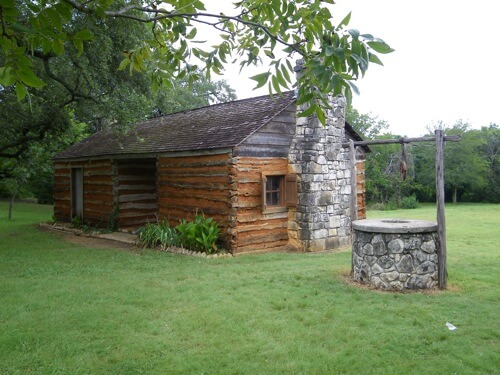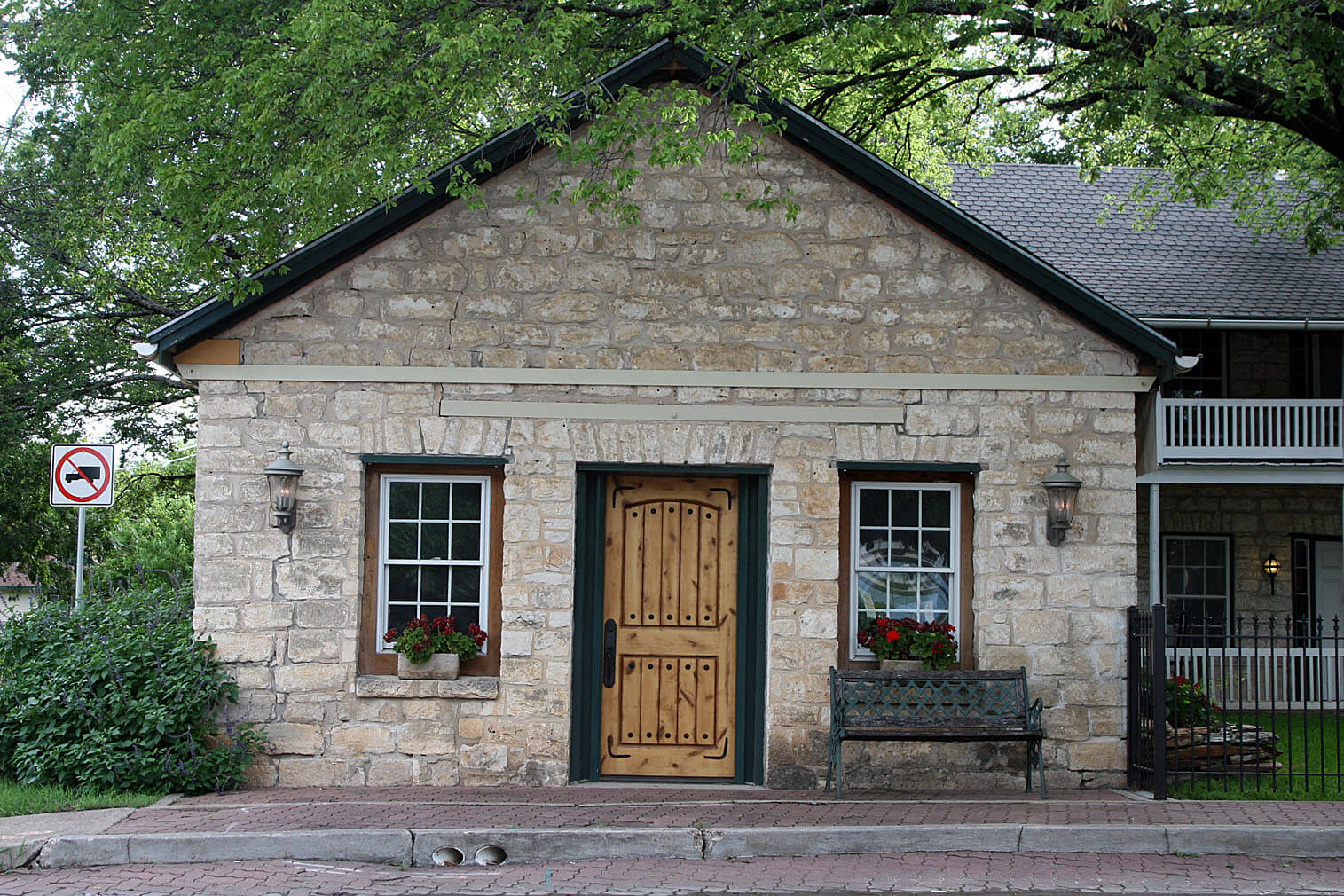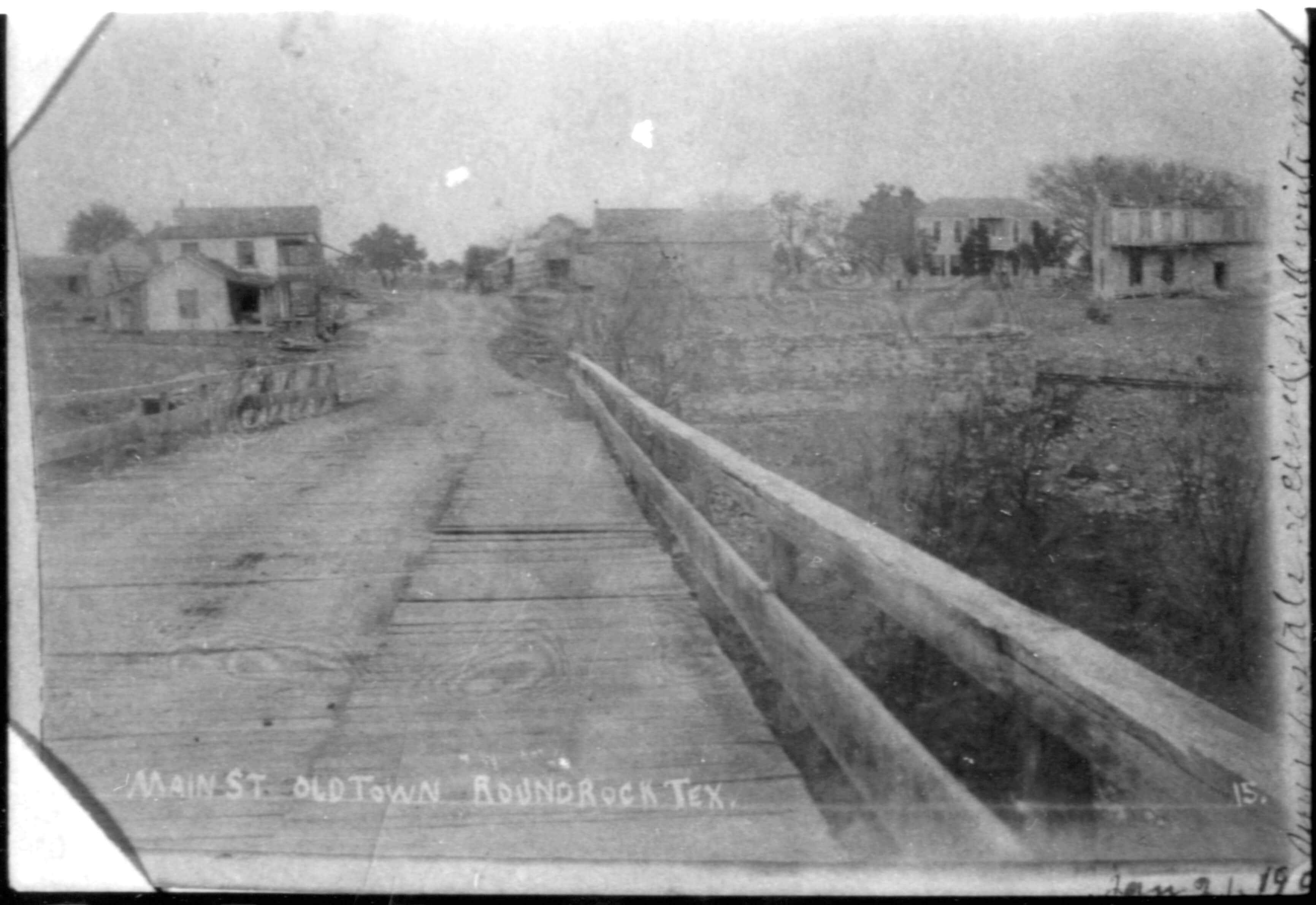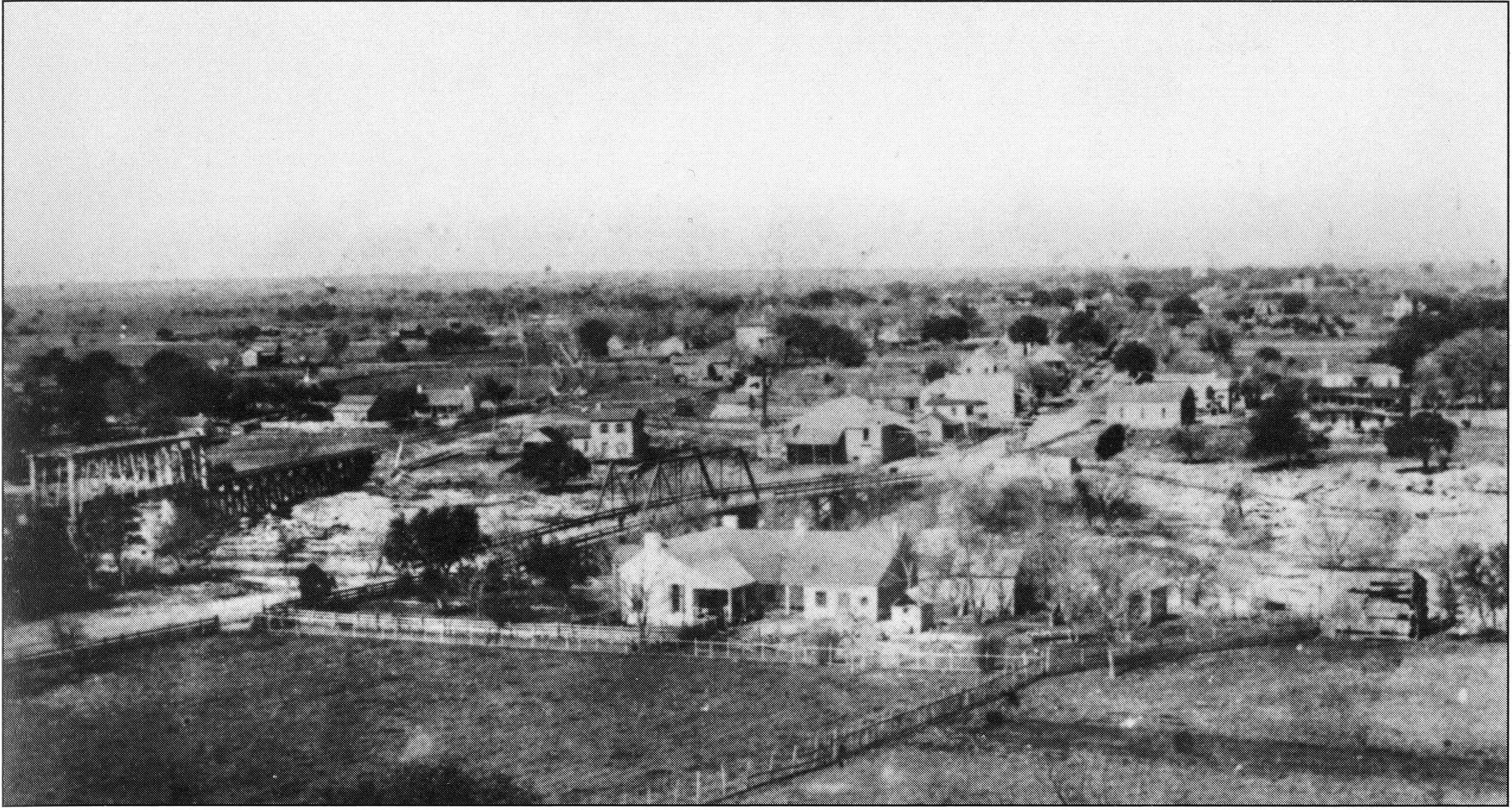The Historic Round Rock Collection
The Story of Old Town
The Historic Round Rock Collection is a project documenting Round Rock’s history, funded in part with a grant from the Texas Historical Commission. These pages are adapted from the original 1991 print version.
Originally, Round Rock was not named Round Rock, nor was it located where it currently is. Coincidence and fate combined to determine the location of Round Rock.
The initial settlement of Brushy (as the town was originally called) was located near the banks of Brushy Creek at the natural fording area by the round rock. This settlement grew, despite a succession of floods, and flourished until the coming of the International and Great Northern Railroad in 1876 forced the commercial area of Round Rock to move to the east, leaving the original settlement to be referred to as Old Town forever more.

One of the first settlers of what was to become Old Town was Jacob M. Harrell. Harrell was Austin’s first blacksmith but he chose to move his shop and house to the north bank of Brushy Creek in the spring of 1848 (the family cemetery that he established can be viewed today at the intersection of Bowman Road and Interstate 35). The summer of that same year, Williamson County’s first school was constructed in a log cabin two miles southwest of present day Round Rock; a Mr. Allen was the first teacher and the list of students included several Round Rock youngsters: Henry Bratton, F.M. Harrell, Azalee Harrell and others (Scarbrough 134). Soon after the establishment of this school, another school was erected north of Brushy Creek by Samuel L. Makemson and D.F. Knight. George W. Layman served as the first teacher at this log cabin school (Ibid. 113-114).
The Harris Stagecoach Inn (also known as the Inn at Brushy Creek) was constructed in 1848 by John Harris. The limestone that was used on the Inn was quarried from the hill upon which it stands; cedar for the floor was carted to the site from Brenham, Texas. The Inn served the stagecoaches that carried mail and passengers from Brownsville to Salado, and from Helena, Arkansas to San Antonio, Texas (Carter 176). Reports from 1853 tell of how Round Rock citizens would gather at the Inn in order to observe the arrival of the stagecaches and their travelers. The arrival of the coach was announced by the sounding of a horn by the coach driver one mile before the Round Rock stop. Mr. Harris kept a flock of geese at the hotel (for the purpose of supplying feathers for the Inn’s beds and pillows) who responded to the horn by honking, bringing much attention to the arriving stage. Mr. Harris, and his wife Susie, were considered to be excellent hosts; rooms at the Inn were reported to be clean and comfortable and the meals served, often consisting of chicken and dumplings, were reportedly delicious (Scarbrough 176).

The Brushy Creek Post Office was established in a section of Thomas C. Oatts’ store on May 27, 1851. However in 1854, postal authorities asked Mr. Oatts to provide another name for the settlement (being that there was already a town in the State that called itself Brushy). Mr. Oatts decided to rename the town Round Rock in recognition of the large rock in the middle of Brushy Creek where he and Jacob Harrell spent much time sitting and fishing; thus on August 24, 1854, the name of Round Rock was officially given to the community (Scarbrough 310).
In 1852, a private company contracted with the Federal Government to carry the mail between San Antonio and Memphis, Tennessee, passing through Austin, Round Rock, Georgetown, Waco and Dallas. This mail line consisted of two “horse hacks” that made two, and later three, trips a week upon this line (Ibid. 145).
The first church service held in the area was in December of 1847 at the home of Freeman Smalley, located east of present day Round Rock. On January 12, 1854, a deed was issued to the Anti-Slave Holding Union Baptist Church trustees (including Zara Stearns, B.F. Smalley and James K. Smalley). In 1855, the Baptists and Presbyterians built a Union Church. This two-story building had an outside stairway that led up to the Masonic Lodge quarters. The Union Church had two doors, one for men and one for women and children. People were summoned to church services, weddings, funerals and Masonic meetings by the ringing of a triangle that hung in a nearby tree (Ibid. 312).
In 1856, T.C. Thompson’s wheat mill was fully operational; that same year Round Rock was included for the first time on the Texas Land Office maps (Ibid. 162 and 149).
In the 1860s, houses and businesses began to sprout along the north shore of Brushy Creek; H.B. Sheppard’s store opened in the winter of 1860, later G.W. “Walsh” Davis and L. Mays’ stores were opened. In 1866, licenses to sell small quantities of liquor were granted to Alex McFarland and S.H. Rutledge (Ibid. 310-311). In the 1860s, land was purchased to establish the Round Rock Academy which may have led to the establishment of the Greenwood Masonic Institute in 1867, which later became the Round Rock College (Ibid. 312).
Events occurring in 1869 included John T. Ricks becoming a partner in H.B. Sheppard’s store and the opening of another store by Henry Harris. 1869 was also the year in which Round Rock’s first documented murder took place. On the evening of June 11, two men came to Dr. J.C. Black’s stone home (the basement of which is rumored to have been used as the town’s first jail) and requested that he prepare them some medicine. After preparing the medicine the doctor stepped outside to examine one of the men who was pretending to be ill. At this point the men shot the doctor through the chest and rode off into the night yelling and firing their guns. Dr. Black, the town’s physician, died soon after from the wound. The motive for the shooting was Dr. Black’s repeated castigation of some local trouble makers (Ibid. 311).
Industry in Round Rock in 1870 was composed of L.M. May’s carding machine, mills owned by B.T. Adams and A. Verse, and a factory that included a gristmill, wool carding machine and a gin all under one roof. In December of 1870, Nat. Q. Henderson began the Round Rock Sentinel, the local newspaper; however, in 1871 publication of the Sentinel was terminated due to financial difficulties. In September of the same year, publication of the newspaper began again. In October of 1872, Henderson moved to Georgetown, taking his newspaper with him (Ibid. 311-312).

A listing of Round Rock businesses open by 1871 included: J.W. Ledbetter (insurance), D.S. Cooke (blacksmith and wagon shop), A. Kuykendall (blacksmith), John Kirkpatrick’s Round Rock Hotel, H.C. Maddox (book seller), R.B. Masterson (saddle shop), John Kirkpatrick’s Restaurant, and E.M. Bolen (tombstones). By 1872, a dry goods, grocery and “receiving house” business had been opened by G.W. Davis, J.B. Davis and H.C. Maddox. In 1873, Mays bought out Davis, his business partner, and then sold half interest of the business to J.M. Black. At some time in the early 1870s, John Peterson set up a blacksmith shop on West Main Street (Ibid. 312).

In 1876, with the coming of the International and Great Northern Railroad, most businesses realized that commercial activity would shift to the new location along the tracks and prepared to abandon Old Town for the New Town location. After the opening of the rail line in 1876, the two Round Rocks functioned and were both shown on maps and official documents as “Old Round Rock” and “New Round Rock”. At times, New Town was referred to as merely Round Rock. On December 16, 1891, the post office at Old Town was closed down; by this time most of Old Town had been abandoned. Interest in Old Town waned until the middle of the twentieth century when individuals began to take an interest in the fine old stone buildings and restoration work began. At this time, the street through Old Town was renamed Chisholm Trail in order to call attention to the historical nature of the area (Ibid. 312-313).
Today, the area has special historical interest and several businesses have restored and then located their shops in these buildings. The restoration of this area can be seen as being an attempt to emphasize the historic past of the City of Round Rock.
Works Cited
Carter, Kathryn Turner. Stagecoach Inns of Texas. Texian Press, Waco, Texas: 1972.
Scarborough, Clara Stearns. 1973. Land of Good Water, Takachue Pouetsu: A Williamson County, Texas History. Williamson County Sun Publishers, Georgetown, Texas.


